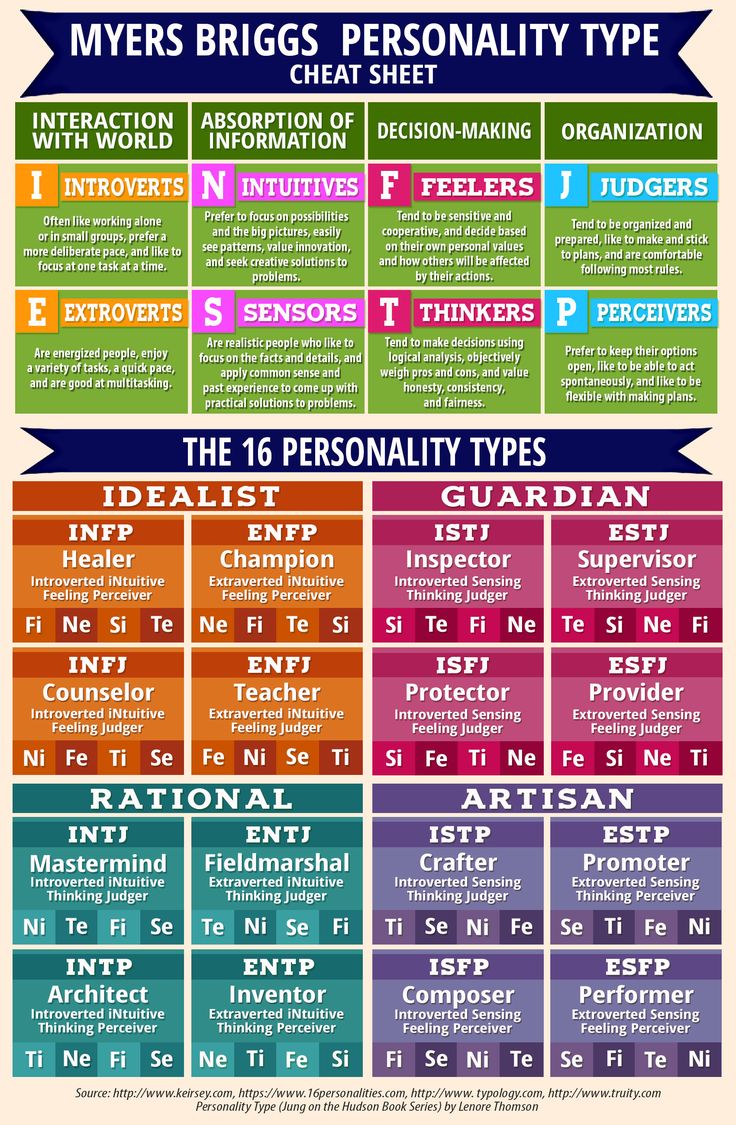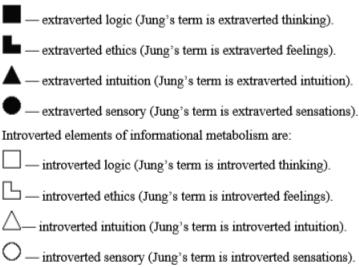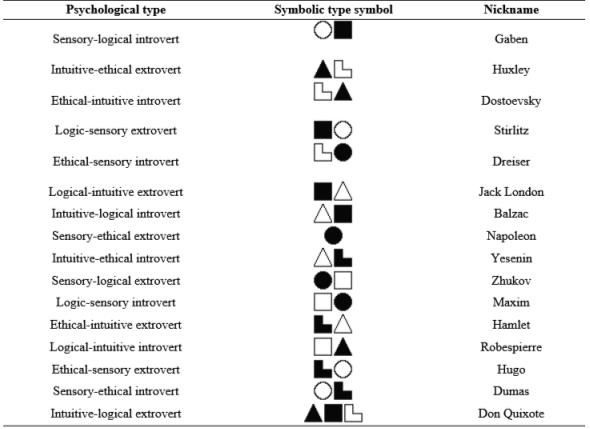Abstract
The paper discusses the theory of psychological types (Jungian Psychological Types Theory), developed by the Swiss psychologist and psychiatrist Carl Gustav Jung. Original interpretations of Jung’s theory were given in the works of American researchers Katharine Cook Briggs and Isabel Briggs Myers, as well as the Soviet researcher from Lithuania Aushra Augustinavichiute, in which Jung’s initial ideas gained their conceptual development. The concept of Briggs and Briggs Myers, as well as the concept of Aushra Augustinavichiute, are two directions that can be conditionally called the “western” branch of the Jungian. The “eastern” branch is represented by the concept of Aushra Augustinavichiute, within which a cybernetic model of the psychological type (Model A) has been created, the theory of intertype relations has been developed, and the terminological apparatus of Jung’s theory has been partially updated. Scientists of Moscow International University on the basis of the Department of Psychology and the “Laboratory of Cognitive Research of Consciousness” have developed new typological conception, within which a new terminological apparatus and a new way of representing and describing a psychological type have been elaborated. Our concept allows accelerating the further development of Jungian Psychological Types Theory in the 21st century.
Keywords: Aushra Augustinavichiute, cognitive concept, field model of psychological type, I Briggs Myers, Jung's typology, K Briggs
Introduction
One of the acute research issues in contemporary differential psychology is the problem of personality. The typological approach has become widespread in the personality study. The most productive personality typology is the Jungian Psychological Types Theory (Jung, 2001; Jung, 2020). The advantage of Jungian Psychological Types Theory is its structural nature; the psyche is considered as a certain structure consisting of a particular number of interconnected elements.
“Typology of Carl Gustav Jung” is fundamentally different from all other typologies, which, generally, are limited to describing people's behaviour and classifying it. Jung is not looking for illnesses or character accentuations, he is searching for structural distinctions in the perception and thinking of completely healthy people, in all relations between normal individuals, in what inclinations, abilities and talents these structures manifest themselves, what life difficulties they lead to (Augustinavichiute, 1995).
The theory of psychological types was first expounded by Jung in the book “Psychologische Touren” in German, published in 1921 in Zurich. Jung (2001) emphasizes that his typology is, primarily, a critical apparatus that serves to distribute and organize the welter of empirical material, but is not intended to label people. Carl Jung notices some typical variabilities between people in the process of observation: some are more inclined to unravel hidden possibilities, others are limited to the perception of specific objects and subjects; for some people it is significant to comprehend the situation intellectually, others are guided by sensory impressions; the fate of some is determined by own subjective interests, while the fate of others is defined by external objects.
Jung worked out a typology of 8 psychological types, revealing groups of counter-psychic mechanisms: 2 attitudes – extraverted and introverted, as well as 4 mental functions, divided into 2 classes – a class of rational functions (thinking and feeling) and a class of irrational functions (sensation and intuition). Jung’s work is an unfinished sketch for a complex theory of psychological types. Jung gives only a contour map of human types, requiring completion.
During the 20th century, the development of the typological concept of Carl Jung took place in two directions, which can be conditionally called the “western” branch of the Jungian Psychological Types Theory and the “eastern” branch of the Jungian Psychological Types Theory.
The “western” direction was formed in the works of American researchers Katharine Cook Briggs and Isabel Briggs Myers, who have been popularizing Jung’s typology in the United States for 40 years (Briggs Myers & Myers, 2014).
Katherine Briggs became familiar with Jung’s concept in 1923 by studying the book “Psychologische Touren” translated into English. She found that Jung had discovered something that she herself had only aspired to. Katherine Briggs began to study Jung's concept in depth, also intriguing her daughter Isabella.
The researchers came to the conclusion that there are not three (like Jung’s), but four parameters – four gradations of personal preferences (extraversion-introversion, thinking-feelings), according to which they expanded Jung’s classification to sixteen personality types (Figure 1).
The researchers’ significant contribution in the development of Jungian Psychological Types Theory was a system of tests that allow revealing a personality type with a particular degree of accuracy – Myers-Briggs Type Indicator or MBTI.
A Soviet researcher from Lithuania, Aushra Augustinavichiute, as a representative of the “eastern” branch of Jung’s typology, also came to the conclusion that there were16 psychological types, also based on four parameters. She worked on creating own interpretation of Jungian Psychological Types Theory in the 1970s. The first work outcomes on the Aushra’s typology were presented in the work “Dual Nature of Man”, published in samizdat in 1978, as well as in the article “Informacinio metabolismo modelis” (Model of Information Metabolism), published in 1980 in the Lithuanian “Mokslas ir technika.”
It should be emphasized that the developments of Aushra were made independently of the studies that were carried out in the USA by K. Briggs and I. Briggs Myers and their followers.
Problem Statement
The Briggs-Briggs Myers concept and the Aushra Augustinavichiute concept have certain shortcomings, namely, the lack of clear terminology and precise definitions of the theory basic concepts.
One of the most fundamental problems of the Aushra Augustinavichiute concept is the lack of a unified and reliable methodology for defining psychological types.
Diverse schools often typify the same people differently (in the opposite way) and have various ideas about the types and methods of diagnostics, which leads socionics to subjectivism and may cast doubt on the possibility of achieving the science status in the future.
Research Questions
The research question is Psychological Types Theory, developed in the works of Carl Jung and further extension in the studies of American, Soviet and Russian researchers.
Purpose of the Study
The study is of a survey-staging nature.
The purpose is to analyze the Psychological Types Theory by Carl Jung, the concepts of Myers-Briggs and Aushra Augustinavichiute, as well as the cognitive concept exposition of psychological types worked out by the authors – scientists of Moscow International University on the basis of the Department of Psychology and the “Laboratory of Cognitive Research of Consciousness.”
Research Methods
The study was carried out using both traditional and modern methods (historical, systemic,structural-functional, and comparative).
The empirical material was composed of scientific articles, monographs, which cover various concepts of psychological type (Augustinavichiute, 1995; Augustinavichiute, 1997; Briggs Myers & Myers, 2014; Jung, 2001; Jung, 2020).
Findings
Jung calls his concept critical psychology, which deals with the study of typical mental processes.
Jung came to the empirical conclusion that there were many typical differences in addition to individual distinctions in human life.
He draws attention to the fact that the life of some people is determined by external objects, while the life of others is defined by subjective moments.
Jung refers to this phenomenon as “extraverted attitude” and “introverted attitude.”
Jung believes that the extraverted and introverted types of attitudes differ in the direction of interest (libido movement) and represent a certain position in relation to the object.
The introverted attitude presupposes an abstract attitude towards the object. A person with a predominantly introverted attitude “... constantly takes care of how to distract the libido from the object, as if he had to protect himself from the excessive power of the object.
The extraverted, on the contrary, relates to the object positively. He affirms its significance insofar as he constantly orients his subjective attitude towards the object and introduces it in relation to him” (Jung, 2001).
Beyond two types of attitudes, Jung also experimentally discovered two pairs of mental functions: a) a pair of rational mental functions – Thinking – Feeling b) a pair of irrational mental functions – Sensing – Intuitive.
“External circumstances and internal disposition not only cause the predominance of extraversion or introversion, but also contribute to the predominance in the individual of one of the main functions over others. Based on experience, I have named the basic psychological functions – namely, those that are essentially different from all others – and. If one of these functions habitually dominates the others, then the corresponding type is formed” (Jung, 2001)
Therefore, the classification of Jung's psychological types consists of three parameters: “extraversion–introversion”, “thinking–feeling” (rational functions), “feeling–intuition” (irrational functions).
The combination of these parameters makes it possible to identify 8 psychological types (Table 1).
The above psychological types are described in detail by Jung (2001) in various works. As noted in the introduction, the typological concept of Carl Jung evolved in two directions, which can be conditionally called the “western” branch and the “eastern” branch. The "western" branch is represented by the work of American researchers Katharine Cook Briggs and Isabel Briggs Myers (Briggs Myers & Myers, 2014).
K. Briggs and I. Briggs Myers came to the conclusion that the type system was based not on three parameters (scales), as it was with Jung, but on four: “extroversion – introversion”, “thinking – feeling”, “feeling – intuition” and “judging – perceiving” (Tieger & Barron-Tieger, 2011).
Thus, the number of psychological types has increased to 16 types.
Moreover, K. Briggs and I. Briggs Myers introduced a system of special characters to designate all parameters of installations, function classes, as well as the functions themselves: E (Extraverted), I (Introverted), J (Judging), P (Perceiving), T (Thinking), F (Feeling), N (Intuitive), S (Sensing).

The “eastern” branch of the Jungian Psychological Types Theory became widespread in the USSR in the works of the Lithuanian researcher Aushra Augustinavichiute (Augustinavichiute, 1997).
Augustinavichiute, like K. Briggs and I. Briggs Myers, updated the terminological apparatus of Jung’s theory.
For example, Augustinavichiute replaced the terms “thinking” and “feeling” with the terms “logic” and “ethics”, since she considered such a name more acceptable.
Besides, Augustinavichiute suggested using the terms “extratim” – “introtim” by analogy with the terms shizothyme – Kretschmer’s cyclothyme to designate installations.
Augustinavichiute worked out a cybernetic model of the psychological type (Model A), in which mental functions are interpreted as elements of a person's informational metabolism.
Augustinavichiute borrowed the term “information metabolism” from the Polish psychiatrist Kempinsky, who likened the information signals received by the human psyche to food received by the body in the process of energy metabolism, that is, just as food is required for energy metabolism, so information signals are necessary for the informational metabolism of the psyche.
Information metabolism is the process of receiving, processing and issuing information (information signals).
Therefore, “... distinctions in personality type are nothing more than differences in the exchange of information signals with the environment ...” (Augustinavichiute, 1997); each type is a specific way of selecting and processing information signals.
Augustinavichiute singled out 8 elements of informational metabolism and proposed special graphic symbols for their designation:

The principles of constructing a psychological type in Augustinavichiute are similar to those of Jung: the type is determined by dominant functions.
An auxiliary function (creative, instrumental) is present in model A in the psychological type in addition to the main dominant function.
Augustinavichiute (1997) wrote that Jung argued and we are convinced in our practice that the character of a person is designated not by one, but two “functions.” When, for example, we say a logical type, we do not know which is logical: the one with sensory or the one with intuition. And they are very different.
For example, intuition is the basic dominant function of the “intuitive-logical introvert”, and logic is the auxiliary function.
The power of functions is measured by four dimensions: experience, norms, situation, and globality.
The most powerful function in model A is the four-dimensional function of the first channel (main).
The second most powerful function is the three-dimensional function of the second channel (auxiliary).
This is followed by the two-dimensional function of the third channel and the one-dimensional function of the fourth channel (the weakest in mental ring of model A).
Thus, sixteen psychological types have been identified in the cybernetic concept of Augustinavichiute (Table 02).

The given concept is detailed in the works of Augustinavichiute (1995; 1997).
We propose to consider the psychological type within the framework of the cognitive paradigm as a system of cognitive operations associated with the reception, processing, storage, and generation of information.
The cognitive operations involve the psychological process analysis and the connection not only with external stimuli, but also with internal variables (self-awareness, selectivity of attention, cognitive strategies, and ideas and desires).
Cognitive science is the result of cognitive revolution and cognitive turn and represents an interdisciplinary scientific direction aimed at studying.
The basic metaphor of classical cognitive science is a computer metaphor, in which human consciousness is considered as an analogue of a computer, and the cognition process is regarded as a process of receiving, processing, storing, and generating information.
The terminology is introduced into scientific circulation within the framework of the proposed cognitive concept of the new psychological type.
Firstly, we propose to use the terms “” and “” instead of the terms “extroversion”, “introversion.”
The expediency of such a terminological replacement is due to the fact that the concepts of extraversion and introversion are currently ambiguous.
They were introduced into scientific circulation by K. Jung, but later received new interpretations in the works of G. Eysenck (within the framework of the personality dispositional model), K. Leonhard (within the framework of the personality accentuation concept), and others.
The above interpretations do not match Jung’s comprehension of extraversion and introversion.
Therefore, we propose to apply new terms: “exoversion” means the orientation of the psyche (subject) to external objects, and “endoversion” – the orientation of the psyche (subject) to internal objects.
Secondly, our concept operates with the term of instead of the terms of types of attitudes, which differ in the movement of “libido” (“psychic energy”).
The concept of “libido” (“psychic energy”) is vague and speculative in its content and is more consistent with the foundations of psychoanalysis.
Our concept is cognitive (not related to psychoanalysis), so the term of “libido” is completely eliminated from our terminological apparatus.
Intentionality is the direction of human consciousness to particular objects.
If the consciousness of the subject is directed to external objects, then we speak of.
If the direction of consciousness goes “from external objects to internal”, then we mean.
Thirdly, the letter designations of the corresponding functions are used in our concept: L (logitive function), E (emotive function), S (sensitivity function), I (intuitive function).
Types of intentionality are denoted by signs: exoverted intentionality is marked with a “+” sign (outward orientation), and endoverted intentionality is indicated with a “-” sign (inward orientation, avoidance of external objects).
Thus, each of the four functions has two directions, like two sides of the same coin: exoverted (E+, S+, L+, I+) and endoverted (E-, S-, L-, I-).
Conclusion
Jungian Psychological Types Theory has received a fairly thorough development during the 20th century.
Currently, the “western” and “eastern” directions of Jungian Psychological Types Theory coexist successfully.
The “western” direction is mainly actively developing in the USA and the EU countries, and the “eastern” direction – in the countries of the former Soviet Union (Russia, Ukraine, Lithuania, etc.).
Some scholars believe that the Myers-Briggs concept is less consistent with Jung's theory than the Aushra Augustinavichiute’s concept (Filatova, 2012).
Other authors believe that both concepts are equally inconsistent with Jung's original typology, since they have transformed the terminology (Ilyashevich & Lytov, 2006).
Our concept, on the one hand, makes up for certain shortcomings in the Jung’s studies, as well as those of Myers-Briggs and Aushra Augustinavichiute, and, on the other hand, enriches the Jungian Psychological Types Theory.
References
Augustinavichiute, A. (1995). Commentary on Jung’s typology and introduction to information metabolism. Socionics, mentology and personality psychology, 2, 22–22. https://socionics.socionic.info/en/soc_95_2.html
Augustinavichiute, A. (1997). On the dual nature of man. Kyiv, Publishing house of the International Institute of Socionics.
Briggs Myers, I., & Myers, P. (2014). MBTI: Type definition. Everyone has own gift. Career Press.
Filatova, E. S. (2012). Psychology and socionics: together or apart? Exlibris-Nord.
Ilyashevich, A. M., & Lytov, D. A. (2006). Evolution of Jung’s views on typology. Psychology at the university, 1, 98–126.
Jung, K. (2001). Psychological types. Azbuka.
Jung, K. (2020). Tavistock Lectures. Publishing house “Institute for General Humanitarian Research”.
Tieger, P., & Barron-Tieger, B. (2011). Do What You Are: Discover the Perfect Career for you Through the Secrets of Personality Type. Little Brown and Company.
Copyright information

This work is licensed under a Creative Commons Attribution-NonCommercial-NoDerivatives 4.0 International License.
About this article
Publication Date
25 November 2022
Article Doi
eBook ISBN
978-1-80296-127-0
Publisher
European Publisher
Volume
128
Print ISBN (optional)
-
Edition Number
1st Edition
Pages
1-742
Subjects
Sociolinguistics, linguistics, semantics, discourse analysis, translation, interpretation
Cite this article as:
Makhaev, M. R., Mamalova, K. E., & Akhmadova, Z. M. (2022). Jungian Psychological Types Theory: Introduction To The New Cognitive Conception. In D. Bataev, S. A. Gapurov, A. D. Osmaev, V. K. Akaev, L. M. Idigova, M. R. Ovhadov, A. R. Salgiriev, & M. M. Betilmerzaeva (Eds.), Social and Cultural Transformations in the Context of Modern Globalism (SCTCMG 2022), vol 128. European Proceedings of Social and Behavioural Sciences (pp. 420-428). European Publisher. https://doi.org/10.15405/epsbs.2022.11.58

